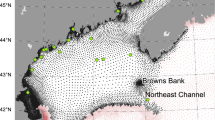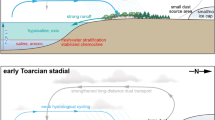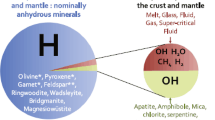Abstract
Modern and ancient saline lakes are important sites for the deposition of carbonates and evaporites. Here we describe a generalized computer model of chemical sediment production in a closed-basin lake subject to: (1) variable inflow sources through time; (2) variable volumes of these inflows; (3) variable temperature, and; (4) variable evaporation rates through time. We then apply our model to gain insights into some aspects of late Pleistocene evaporite deposits beneath Searles Lake, California, a well-described chemical sedimentary deposit. We tuned our model to match the masses and proportions of the major saline minerals trona and halite deposited in layers circa 32 ka to 24 ka. However, we could not reproduce the thicknesses of mixed siliciclastic, carbonate and organic layers sandwiched between the evaporites. The model is useful for interpreting and constraining the environmental conditions in and around any ancient saline lakes during evaporite deposition where the amounts, mineralogies, and vertical distribution of chemical sediments are known.








Similar content being viewed by others
References
Bischoff JL, Rosenbauer RJ, Smith GI (1985) Uranium-series dating of sediments from Searles Lake; differences between continental and marine climate records. Science 227:1222–1224
Bischoff JL, Fitts JP, Fitzpatrick JA (1997) Responses of sediment chemistry to climate change in Owens Lake sediments; an 800-ky record of saline/fresh cycles in Core OL-92. In: Smith GI, Bischoff JL (eds) An 800,000-year paleoclimatic record from core OL-92, Owens Lake, southeast California. Geological Society of America Special Papers, vol 317, pp 37–47
Bridge J, Demicco R (2008) Earth surface processes, landforms and sediment deposits. Cambridge University Press, Cambridge
Flint RF, Gale WA (1958) Stratigraphy and radiocarbon dates at Searles Lake, California. Am J Sci 256:689–714
Gavrieli I, Bein A, Oren A (2005) The deteriorating Dead Sea basin: limnological and environmental changes and the expected impact of the “Peace Conduit”. Mitig Adapt Strateg Glob 10:3–22
Hardie LA, Eugster HP (1970) The evolution of closed-basin brines. Min Soc Am Spec 3:273–290
Hardie LA, Smoot JP, Eugster HP (1978) Saline lakes and their deposits: a sedimentological approach. In: Matter A, Tucker ME (eds) Modern and ancient lake sediments. Special Publication, pp 7–41
Harvie CE, Moller N, Weare JH (1984) The prediction of mineral solubilities in natural waters: the Na–K–Mg–Ca–H–Cl–SO4–OH–HCO3–CO3–CO2–H2O system to high ionic strengths at 25 °C. Geochim Cosmochim Acta 48:723–751
Hollett KJ, Danskin WR, McCaffrey WF, Walti CL (1991) Geology and water resources of Owens Valley, California: U.S. Geological Survey Water-Supply Paper 2370-B
Ives PC, Levin B, Robinson RD, Rubin M (1964) U.S. Geological Survey radiocarbon dates VII. Radiocarbon 6:37–76
Jagniecki EA, Lowenstein TK (2015) Evaporites of the Green River Formation, Bridger and Piceance Creek Basins: deposition, diagenesis, paleobrine chemistry, and Eocene atmospheric CO2. In: Smith ME, Carroll AR (eds) Stratigraphy and paleolimnology of the Green River Formation, Western USA. Springer, Dordrecht, pp 277–312
Jagniecki EA, Lowenstein TK, Jenkins DM, Demicco RV (2015) Eocene atmospheric CO2 from the nahcolite proxy. Geology 43(12):1075–1078
Krumgalz BS, Hecht A, Starinsky A, Katz A (2000) Thermodynamic constraints on Dead Sea evaporation: can the Dead Sea dry up? Chem Geol 165(1):1–11
Lensky NG, Dvorkin Y, Lyakhovsky V, Gertman I, Gavrieli I (2005) Water, salt, and energy balances of the Dead Sea. Water Resour Res 41:W12418
Lin JC, Broecker WS, Hemming SR, Hajdas I, Anderson RF, Smith GI, Kelley M, Bonani G (1998) A reassessment of U-Th and 14 C ages for late-glacial high-frequency hydrological events at Searles Lake, Water, salt, and energy balances of the Dead Sea. Quat Res 49(1):11–23
Lowenstein TK, Li J, Brown C, Roberts SM, Ku TL, Luo S, Yang W (1999) 200 ky paleoclimate record from Death Valley salt core. Geology 27(1):3–6
Lowenstein TK, Dolginko LAC, García-Veigas J (2016) Influence of magmatic hydrothermal activity on brine evolution in closed basins: Searles Lake, California. Geol Soc Am Bull 128:1555–1568
Marion GM (2001) Carbonate mineral solubility at low temperatures in the Na-K-Mg-Ca-H-Cl-SO4-OH-HCO3-CO3-CO2-H2O system. Geochim Cosmochim Acta 65(12):1883–1896
Mero F, Simon E (1985) A daily simulation model for evaluation of future Dead Sea levels. In: Scientific basis for water resources management (proceedings of the Jerusalem symposium), vol 153, pp 265–276
Pitzer KS (1991) Ion interaction approach: theory and data correlation. Act Coeff Electrolyte Solut 2:75–153
Plummer LN, Parkhurst DL, Fleming GW, Dunkle SA (1988) A computer program incorporating Pitzer’s equations for calculation of geochemical reactions in brines. U.S. Geological Survey, Water-Resources Investigations Report 88-4153
Renaut RW, Gierlowski-Kordesch EH (2010) Lakes. In: Dalrymple RW, James NP (eds) Facies models, vol 4. Geological Association of Canada, Toronto, pp 541–575
Risacher F, Clement A (2001) A computer program for the simulation of evaporation of natural waters to high concentration. Comput Geosci 27:191–201
Rubin M, Berthold SM (1961) U.S. Geological Survey radiocarbon dates VI. Radiocarbon 3:86–98
Smith GI (1979) Subsurface stratigraphy and geochemistry of late Quarternary evaporites, Searles Lake, California. U.S. Geological Survey Professional Paper 1043
Smith GI (2009) Late Cenozoic geology and lacustrine history of Searles Valley, Inyo and San Bernardino Counties, California. U.S. Geological Survey Professional Paper 1727
Smith GI, Street-Perrot FA (1983) Pluvial lakes of the western United States. In: Wright HE Jr (ed) Late-quaternary environments of the United States. University of Minnesota Press, Minneapolis, pp 190–212
Smoot JP, Lowenstein TK (1991) Depositional environments of non-marine evaporites. In: Melvin JL (ed) Evaporites, petroleum, and mineral resources. Elsevier, Amsterdam, pp 189–347
Steinhorn I (1983) In situ salt precipitation at the Dead Sea. Limnol Oceanogr 28(3):580–583
Stuiver M (1964) Carbon isotopic distribution and correlated chronology of Searles Lake sediments. Am J Sci 262(3):377–392
Stumm W, Morgan JJ (1981) Aquatic Chemistry, 2nd edn. Wiley, New York
Author information
Authors and Affiliations
Corresponding author
Additional information
Publisher's Note
Springer Nature remains neutral with regard to jurisdictional claims in published maps and institutional affiliations.
Rights and permissions
About this article
Cite this article
Janick, J.J., Demicco, R.V. Using a coupled geochemical/physical mass balance model to gain insights into the deposition of subrecent evaporites: Searles Valley, California, USA. J Paleolimnol 62, 105–120 (2019). https://doi.org/10.1007/s10933-019-00077-1
Received:
Accepted:
Published:
Issue Date:
DOI: https://doi.org/10.1007/s10933-019-00077-1




